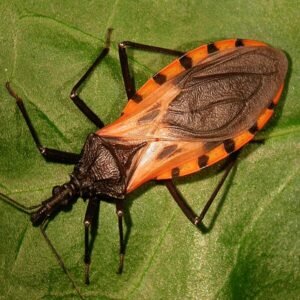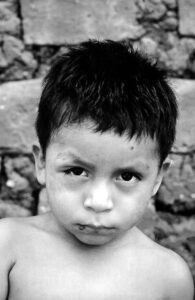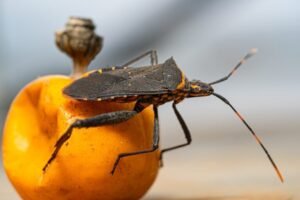When Emiliana Rodríguez was a child, she watched a friend drop dead during a nighttime soccer game. This sudden death frightened her, and she learned it was caused by Chagas disease, which she was told only comes out at night. This disease is carried by nocturnal bugs and affects up to 8 million people each year. Unfortunately, it kills about 12,000 people annually.
At 42, Rodríguez, who moved from Bolivia to Barcelona 27 years ago, discovered that she couldn’t escape Chagas. She still refers to it as a “monster” and often felt scared at night, worrying she might not wake up.
Eight years ago, while pregnant with her first child, Rodríguez found out through tests that she was a carrier of Chagas. She was overwhelmed with fear, thinking about the stories of people who had suddenly died and worrying about her baby’s future.

Rodríguez received treatment to prevent Chagas from passing to her baby. Thankfully, her baby girl tested negative after birth.
In Mexico, Elvira Idalia Hernández Cuevas didn’t know about Chagas until her 18-year-old child was diagnosed with it. While donating blood in Veracruz, her sample tested positive for the disease, which is caused by blood-sucking bugs known as kissing or vampire bugs.
“I had never heard of Chagas,” Hernández said. “I was scared when I read about it being a silent killer. I didn’t know what to do or where to go.”
Many people are unaware of Chagas, a disease caused by these bugs. It was first identified in 1909 by Brazilian physician Carlos Ribeiro Justiniano Chagas. Today, Chagas disease is common in Latin America but can also be found in North America, Europe, Japan, and Australia.

Kissing bugs usually live in the walls of low-income homes in rural or suburban areas. They are most active at night, when people are asleep. The bugs spread Chagas disease by biting someone and then defecating on their skin. The person might scratch the bite or accidentally spread the feces into their eyes or mouth, which can cause infection.
According to the Centers for Disease Control and Prevention (CDC), about 8 million people in Mexico, Central America, and South America have Chagas disease. The World Health Organization (WHO) reports that 6 to 7 million people worldwide are infected. Many of these people are unaware of their infection. If left untreated, Chagas disease can be deadly. Around 12,000 people die from it each year, making it a more serious health threat in Latin America than other parasite diseases like malaria.
While kissing bugs have been found in the U.S., where nearly 300,000 people are infected, Chagas is not considered widespread there.
Some people with Chagas disease may not show symptoms, but decades later, 20 to 30% of them might develop serious heart or gastrointestinal problems. The global detection rate for Chagas is only about 10%, making treatment and prevention very challenging.

Hernández and her daughter Idalia struggled to find help when Idalia was diagnosed with Chagas. They visited many doctors who were unfamiliar with the disease and didn’t know how to treat it. Hernández felt scared and frustrated, fearing for her daughter’s life and unable to find reliable information.
Eventually, they got assistance from a family member in healthcare, and Idalia received the necessary treatment. Hernández criticized the Mexican authorities, saying they downplay the number of Chagas cases and fail to train medical professionals properly. Many doctors mistake Chagas for other heart diseases and are unaware of its presence in Mexico.
Chagas disease is considered a neglected tropical disease by the World Health Organization (WHO), meaning it doesn’t get much attention in global health policies. Colin Forsyth from the Drugs for Neglected Diseases Initiative (DNDi) explained that Chagas is often overlooked because it is asymptomatic for a long time and affects poor populations who lack influence in healthcare policy.
The disease is becoming more visible as it spreads to other continents and is known to be transmitted through blood transfusions, organ transplants, and from mother to baby during pregnancy or childbirth.
Professor David Moore from the Hospital for Tropical Diseases in London established the Chagas Hub to improve testing, treatment, and transmission risk management in the UK. However, he notes that progress in eliminating Chagas is slow, and it’s unlikely the WHO’s 2030 elimination target will be met.
Chagas can be treated with two old medicines, benznidazole and nifurtimox. While they can cure the disease in babies, they are toxic and not very effective for adults.

Rodríguez experienced severe side effects from her Chagas treatment, including hives, dizziness, and nausea. Despite these challenges, she completed her treatment and continues to have annual check-ups.
Professor David Moore emphasizes the need for more effective medication to control Chagas. Unfortunately, pharmaceutical companies currently lack financial incentives to develop better treatments.
In the meantime, Hernández is dedicated to raising awareness about Chagas. As president of the International Federation of Associations of People Affected by Chagas Disease (FINDECHAGAS), she is working to make the disease more visible and advocate for better resources and support.